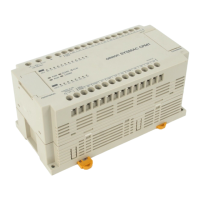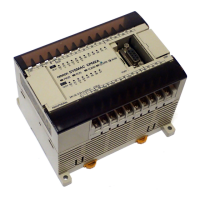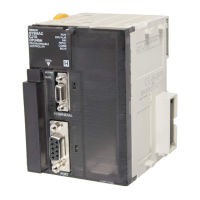114
5-1 Notation
In the remainder of this manual, instructions will be referred to by their mnemon-
ics. For example, the OUTPUT instruction will be called OUT; the AND LOAD
instruction, AND LD. If you’re not sure of the instruction a mnemonic is for, refer
to
Appendix B Programming Instructions
.
If an instruction is assigned a function code, it will be given in parentheses after
the mnemonic. These function codes, which are 3-digit decimal numbers, can
be used to input instructions into the CPU and are described briefly below. A
table of instructions listed in order of function codes is also provided in
Appendix
B
.
An up or down arrow, j or i, at the beginning of a mnemonic indicates a differen-
tiated up or down version of that instruction. An exclamation mark, !, before a
mnemonic indicates an immediate refresh version of that instruction. Differen-
tiated and immediate refresh instructions are explained on page 117.
5-2 Instruction Format
Most instructions have at least one or more operands associated with them. Op-
erands indicate or provide the data on which an instruction is to be performed.
These are sometimes input as the actual numeric values (i.e., as constants), but
are usually the addresses of data area words or bits that contain the data to be
used. A bit whose address is designated as an operand is called an operand bit;
a word whose address is designated as an operand is called an operand word.
In some instructions, the word address designated in an instruction indicates the
first of multiple words containing the desired data.
Each instruction requires one or more words in Program Memory. The first word
is the instruction word, which specifies the instruction and contains any defin-
ers (described below) or operand bits required by the instruction. Other oper-
ands required by the instruction are contained in following words, one operand
per word. Some instructions require up to four words.
A definer is an operand associated with an instruction and contained in the
same word as the instruction itself. These operands define the instruction rather
than telling what data it is to use. Examples of definers are timer and counter
numbers, which are used in timer and counter instructions to create timers and
counters, as well as jump numbers, which define which JUMP instruction is
paired with which JUMP END instruction. Bit operands are also contained in the
same word as the instruction itself, although these are not considered definers.
5-3 Data Areas, Definers, and Flags
Each instruction is introduced with a frame that shows the basic form of the
instruction, the variations of the instruction, and the data areas that can be used
for each operand, as shown in the following illustration
Data areas allowed for operandsBasic ladder symbol
(210)
SA N1 N2
N2: Subchart number ST or 9999
N1: Step number ST
Operand Data AreasLadder Symbol
Variations
j SA
Instruction variations available
Data Areas, Definer Values, and Flags Section 5-3

